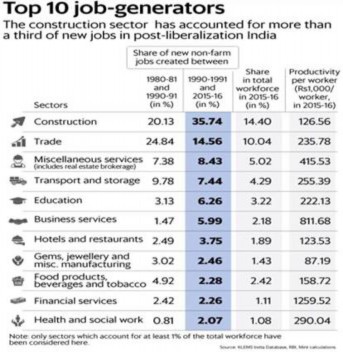4. Potential Sectors for Employment Generation
At present almost half of India’s population is concentrated in the agricultural sector. In fact the agricultural sector shows signs of disguised employment and low productivity. There is an urgent need to take workforce out of this sector towards manufacturing and services. Creating jobs in the latter sectors is India’s central challenge. India needs to generate jobs that are formal and productive, provide bang-for-buck in terms of jobs created relative to investment, have the potential for broader social transformation, and can generate exports and growth.
Moreover, India's growth has to be led by manufacturing, not services because, among other reasons, employment elasticity is higher in manufacturing. Also, a large section of the labour force has little or no education, and cannot be employed in skilled jobs in the services sector. Nor can they be easily skilled, given their lack of basic education. Outside agriculture, they can only be employed in low-skill jobs in the manufacturing sector.

Meeting the challenge of jobs may require paying attention to labour-intensive sectors. The apparel and leather sectors meet many desirable attributes for policy attention: bang- for buck for creating jobs, especially for women, opportunities for exports and growth. Nearly every successful economic growth take-off in post-war history in East Asia has been associated with rapid expansion in clothing and footwear exports in the early stages. Apparels and Leather sectors offer tremendous opportunities for creation of jobs, especially for women.

25 focus sectors under MSME
‘Make in India’ aims at projecting India as an investment destination and develop it as a global hub for manufacturing, design and innovation. The ‘Make in India’ initiative does not target manufacturing sector alone, but also aims at promoting entrepreneurship in the country. Under the initiative various components have been identified which will lead to creation of a positive investment climate. These components involve improvement in Ease of Doing Business, creation of modern infrastructure, opening of new Sectors for FDI and change in the mindset of government agencies from being regulators to facilitators.
As part of Make in India initiative, 25 focus sectors have been identified in which there is an Action Plan which has been approved to encourage and promote investments in those sectors. These sectors include Textiles, Tourism and Hospitality, Leather, Pharmaceuticals, Electronic System Design and Manufacturing, Food processing, construction, Aviation etc.
Rising labor costs means that China is gradually vacating its dominant position in these sectors, affording India an opportunity. To not cede this space to competitors such as Vietnam and Bangladesh will require easing restrictions on labor regulations, negotiating FTAs with major partners such as the EU and UK, and ensuring that the GST rationalizes current tax policy that can discriminate against dynamic sectors.

Employment prospects in India’s IT Sector: Robust Outlook
Indian IT sector employment prospects, both in the near and long-term are expected to be broadly positive and encouraging for the future. India IT companies currently serve two thirds of the fortune 500 companies and have created 40 lakhs direct jobs in India.
India’s total software product market grew at 9.5% in FY2017 to reach USD 7 billion. In comparison, the domestic market grew much faster, at 10.4%, reaching USD 4.8 billion.
The emerging and promising digital economy in the country is going create a very powerful potential for job creation. The Government is encouraging greater stress on cyber security and this will lead to greater focus on innovation, research and thus significant potential for job creation.
